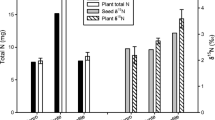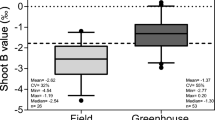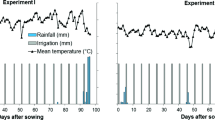Abstract
Aims
The 15N natural abundance technique is increasingly being used to biological nitrogen (N2) fixation by legume crops, but requires the determination of a ‘B value’ which describes the isotopic fractionation for a given plant species and strain of rhizobium. Most B values in the literature are derived for shoot tissue harvested at mid pod filling, when plant N content is generally at its maximum. However, if legumes are grown as green manure inter-crops and growth is terminated at earlier stages, to obtain accurate values for total N2 fixed growth-stage specific B values and correction for seed N contributions may be necessary. This study aimed to evaluate the magnitude of the impact of different values of the N content and 15N abundance of seeds and of B values on the estimates of the proportion of legume N derived from N2 fixation.
Methods
We investigated whether B values at pod filling differ from those at earlier growth stages by growing chickpea (Cicer arietinum), white lupin (Lupinus albus), field pea (Pisum sativum) and two faba bean (Vicia faba) cultivars, in sand-culture in a glasshouse without N, and quantifying the δ15N values of nodules, roots and shoots at five growth stages including mid pod filling as a control. We then used simulations to investigate the degree of error associated with the use of growth stage-inappropriate or B values uncorrected for seed N on estimates of % N derived from atmosphere (%Ndfa).
Results
While the differences in B values between flowering and pod filling were only statistically significant at P < 0.1 for white lupin, there was a trend of declining B value with plant age for chickpea and faba beans. Simulations using data from large (Aguadulce) and small (Fiesta)-seeded faba bean cultivars indicated that the magnitude of potential errors in estimating %Ndfa using B values derived at inappropriate growth stages or uncorrected for seed N content were around 10% at early flowering in both faba bean cultivars and were negligible by late flowering (69 days after sowing).
Conclusions
Where legumes are grown until flowering or beyond, the magnitude of potential error in estimation of %Ndfa from the use of B values derived at inappropriate growth stages or uncorrected for seed N content is relatively low compared to other sources of error encountered when employing the 15N natural abundance technique.


Similar content being viewed by others
References
Angus JF, Peoples MB (2013) Nitrogen from Australian dryland pastures. Crop Pasture Sci 63:746–758
Angus JF, Kirkegaard JA, Hunt JR, Ryan MH, Ohlander L, Peoples MB (2015) Break crops and rotations for wheat. Crop Pasture Sci 66:523–552
Betencourt E, Duputel M, Colomb B, Desclaux D, Hinsinger P (2012) Intercropping promotes the ability of durum wheat and chickpea to increase rhizosphere phosphorus availability in a low P soil. Soil Biol Biochem 46:181–190
Boddey RM, Oliveira OC, Alves BJR, Urquiaga S (1995) Field application of the 15N isotope dilution technique for the reliable quantification of plant-associated biological nitrogen fixation. Fertil Res 42:77–87
Boddey RM, Peoples MB, Palmer B, Dart PJ (2000) Use of the 15N natural abundance technique to quantify biological nitrogen fixation by woody perennials. Nutr Cycl Agroecosyst 57:235–270
Dissanayaka DMSB, Maruyama H, Masuda G, Wasaki J (2015) Interspecific facilitation of P acquisition in intercropping of maize with white lupin in two contrasting soils as influenced by different rates and forms of P supply. Plant Soil 390:223–236
Dordas CA, Vlachostergios DN, Lithourgidis AS (2012) Growth dynamics and agronomic-economic benefits of pea–oat and pea–barley intercrops. Crop Pasture Sci 63:45–52
Drinkwater LE, Wagoner P, Sarrantonio M (1998) Legume-based cropping systems have reduced carbon and nitrogen losses. Nature 396:262–265
Elias NV, Herridge DF (2014) Crop-available water and agronomic management, rather than nitrogen supply, primarily determine grain yield of commercial chickpea in northern new South Wales. Crop Pasture Sci 65:442–452
Herrara JM, Rubio G, Häner LL, Delgado JA, Lucho-Constantino CA, Islas-Valdez S, Pellet D (2016) Emerging and established technologies to increase nitrogen use efficiency in cereals. Agronomy 6:25. https://doi.org/10.3390/agronomy6020025
Herridge DF, Peoples MB, Boddey RM (2008) Global inputs of biological nitrogen fixation in agricultural systems. Plant Soil 311:1–18
Jensen ES, Anderson AJ, Thomsen JD (1985) The influence of seed-borne N in 15N isotope dilution studies with legumes. Acta Agric Scand 35:438–443
Karpenstein-Machan M, Stuelpnagel R (2000) Biomass yield and nitrogen fixation of legumes monocropped and intercropped with rye and rotation effects on a subsequent maize crop. Plant Soil 218:215–232
Li H, Zhang F, Rengel Z, Shen J (2014) Rhizosphere properties in monocropping and intercropping systems between faba bean (Vicia faba L.) and maize (Zea mays L.) grown in a calcareous soil. Crop Pasture Sci 64:976–984
López-Bellido FJ, López-Bellido RJ, Redondo R, López-Bellido L (2010) B value and isotopic fractionation in N2 fixation by chickpea (Cicer arietinum L.) and faba bean (Vicia faba L.) Plant Soil 337:425–434
Nebiyu A, Huygens D, Upadhayay HR, Diels J, Boeckx P (2014) Importance of correct B value determination to quantify biological N2 fixation and N balances of faba beans (Vicia faba L.) via 15N natural abundance. Biol Fertil Soils 50:517–525
Okito A, Alves BRJ, Urquiaga S, Boddey RM (2004) Isotopic fractionation during N2 fixation by four tropical legumes. Soil Biol Biochem 36:1179–1190
Pauferro N, Guimarães AP, Jantalia CP, Urquiaga S, Alves BJR, Boddey RM (2010) 15N natural abundance of biologically fixed N2 in soybean is controlled more by the Bradyrhizobium strain than by the variety of the host plant. Soil Biol Biochem 42:1694–1700
Peoples MB, Baldock JA (2001) Nitrogen dynamics of pastures: nitrogen fixation inputs, the impact of legumes on soil nitrogen fertility, and the contributions of fixed nitrogen to Australian farming systems. Aust J Exp Agric 41:327–346
Reckling M, Hecker J-M, Bergkvist G, Watson CA, Zander P, Schläfke N, Stoddard F, Eory V, Topp CFE, Maire J, Bachinger J (2015) A cropping system assessment framework—evaluating effects of introducing legumes into crop rotations. Eur J Agron 76:186–197
Rose TJ, Rengel Z, Ma Q, Bowden JW (2008) Post-flowering supply of P, but not K, is required for maximum canola seed yields. Eur J Agron 28:371–379
Rose TJ, Julia CC, Shepherd M, Rose MT, Van Zwieten L (2015) Faba bean is less susceptible to fertiliser N impacts on biological N2 fixation than chickpea in monoculture and intercropping systems. Biol Fertil Soils 52:271–276
Roskoski JP (1982) Nitrogen fixation in a Mexican coffee plantation. Plant Soil 67:283–291
Sanches-Pacheco R, Boddey RM, Alves BJR, Straliotto R, Araújo AP (2017) Growth patterns of common bean cultivars affect the 'B' value required to quantify biological N2 fixation using the 15N natural abundance technique. Plant Soil. https://doi.org/10.1007/s11104-017-3331-9
Shearer G, Kohl DH (1986) N2 fixation in field settings: estimations based on natural 15N abundance. Aust J Plant Physiol 13:699–756
Snapp SS, Swinton SM, Labarta R, Mutch D, Black JR, Leep R, Nyiraneza J, O'Neil K (2005) Evaluating cover crops for benefits, costs and performance within cropping system niches. Agron J 97:322–332
Timilsena YP, Adhikari R, Casey P, Muster T, Gilla H, Adhikari B (2014) Enhanced efficiency fertilisers: a review of formulation and nutrient release patterns. J Sci Food Agric 95:1131–1142
Unkovich MJ (2013) Isotope discrimination provides new insight into biological nitrogen fixation. New Phytol 198:643–646
Unkovich MJ, Pate JS (2000) An appraisal of recent field measurements of symbiotic N2 fixation by annual legumes. Field Crop Res 65:211–228
Unkovich MJ, Pate JS, Sanford P, Armstrong EL (1994) Potential precision of the δ15N natural abundance method in field estimates of nitrogen fixation by crop and pasture legumes in south-west Australia. Aust J Agric Res 45:119–132
VSN International (2014) GenStat for windows, 16th edn. VSN International, Hemel Hempstead
Yoneyama T, Fujita K, Yoshida T, Matsumoto T, Kambayashi I (1986) Variation in natural abundance of 15N among plant parts and in 15N/14N fractionation during N2 fixation in the legume rhizobia symbiotic system. Plant Cell Physiol 27:791–799
Author information
Authors and Affiliations
Corresponding author
Additional information
Responsible Editor: Euan K. James
Rights and permissions
About this article
Cite this article
Rose, T.J., Kearney, L.J., Erler, D.V. et al. Influence of growth stage and seed nitrogen on B values and potential contributions to error in estimating biological N2 fixation using the 15N natural abundance method. Plant Soil 425, 389–399 (2018). https://doi.org/10.1007/s11104-018-3600-2
Received:
Accepted:
Published:
Issue Date:
DOI: https://doi.org/10.1007/s11104-018-3600-2




